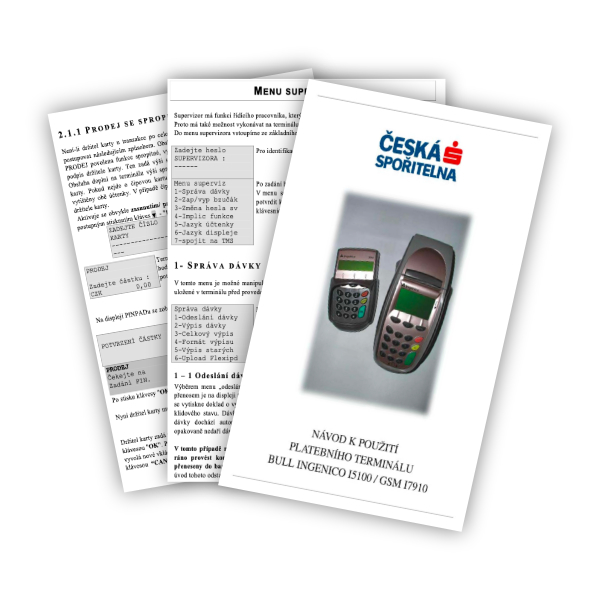Surely you have noticed that in the last year 2021, a completely new and breakthrough product for accepting payment cards came to the market. The hitherto established model where a merchant bought a physical payment terminal from a payment provider has changed. A solution has arrived on the market that can replace a physical device with a simple application to devices running the Android operating system. You say, well, it's not for everyone, this will only be used by someone. On the one hand, you are right, but on the other hand, you could not have been more wrong.
But before we get to the heart of the matter, let's take a look at how we've been paying for the last nearly twenty years and what it takes in the background. In their time, terminals replaced physical irons of cards (as you can see them in older American films) and it was a huge breakthrough. A simple stretch of a plastic card with a magnetic stripe ensured a fairly decent verification of the client for that time that his card represents his money in the account and that he has enough of it there. The terminals were the size of a shoebox, had buttons like a typewriter (and required almost as strong a press) and a two-line green display. I remember a colleague from development who had the privilege of programming a financial app for these devices said that the best feature that managed to develop outside of payments was an alarm clock. So much for what could be done with these devices.
After that, a chip was added to the magnetic strip, but the terminals still offered very limited functionality. However, they could already be connected to cash registers, for example, and it was slowly possible to manage and update them remotely. By the way, did you know that our region has been and has been for some time one of the largest recipients of new technologies in payments? Perhaps that is why the wave of contactless payments was launched in Central Europe. For bank account holders, contactless payments have become a huge breakthrough in the convenience of payment, and today actually more than 95% (and I'm still cautious) in our region is contactless.

But terminals weren't evolving as fast, and they certainly weren't a platform that would allow payment providers (acquirers) to offer some great added services. Slightly larger black and white displays, sometimes even colorful, with that good old physical keyboard just totally overslept the times and it still wasn't a platform that allowed to offer something really "cool". Sure, there were new payment services like DCC, loyalty clubs, but still in terms of cost of acquisition and cost of operation, it was no miracle. It was enough to look at what mobile phones could do in 2015 and what the terminals offered in the same year. I will not forget the sleepless nights with my colleagues researching how, for example, in the coming years to get the EET function into a device with four lines of display and four keys so that it can be used at all. Well, we coped and it certainly enriched us, but we were looking for more electronics that went forward by leaps and bounds. It's probably fair to mention, however, that terminals carry with them all those security regulations, directives, mandates that are churned out in unbelievable numbers by companies defining standards in the payment world. Perhaps that is why not only they, but also their manufacturers have become digital dinosaurs.
Android is behind everything
The first milestone that changed all this was the payment terminals with Android. Although previously some manufacturers came up with devices that separated the payment part from the "freely" accessible and allowed to "create" their own services on the terminal, for example, in HTML5, but unfortunately it was already a swan song for such devices. In addition, thanks to the fact that Android was brought to terminals by manufacturers from Asia, suddenly previously intrepid manufacturers such as Ingenico or Verifone had to make a hell of a effort to have Android terminals in their offer as soon as possible. One solved it by buying an Asian manufacturer, the other practically came up with the Android platform only recently. Android suddenly became a comet for all of us, allowing us to open our heads and thoughts about new features and services. After all, thanks to this, you can upload anything, any application or solution running on Android to the terminal. Isn't that cool? In addition, you can make the work of traders and entrepreneurs much easier. After all, thanks to the new platform, you can come up with a beautiful all-in-one model – terminal, cash register, printer or scanner or camera. You can find many of these solutions on the market today and they make a lot of sense.
Retro terminals with 16 buttons have become beautiful devices with a large touch screen, which completely changed the user experience and control for users. Practically, these are mobile phones with a printer and peripherals for working with cards. There's still a magnetic stripe reader, chips and a contactless NFC chip. To this day, we meet clients who still prefer the original button terminals and it will probably be so for a while. The new terminals have therefore brought a significant change for us and for customers, in terms of administration, costs, maintenance and development, not much has changed and considerable costs have remained. However, it also remained that the entire terminal is fully controlled by the provider and traders can no longer upload applications for security reasons.
The sequel can be found in the second part, which will be released on June 17, 2022
